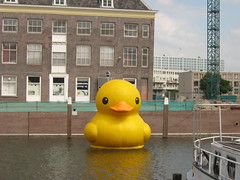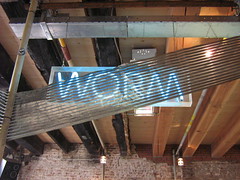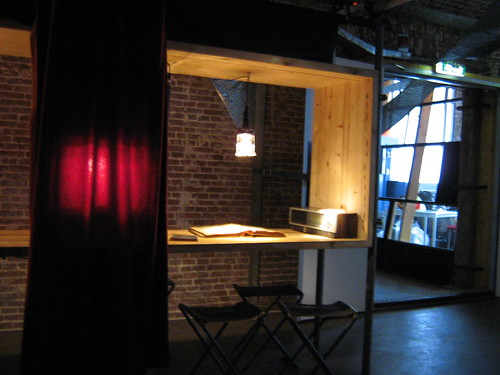I realized that while I’ve written quite a bit about the Piet Zwart first year and graduation shows, and have mentioned them in connection with Worm, but I haven’t said that much about what this school is or what my connection is. I’ll warn you now that if my last post about Worm was alarmingly enthusiastic, well, this one is, hmmmn…ardent?
In brief, my school is developing a new Master’s program, as yet untitled, but basically it’s about media, technology, design…suggestions are welcome! So I’ve been working with other faculty on that idea since early last fall, and then I ran into Florian Cramer, an old friend from grad. school, at MLA 2007 . As it turned out, he is the director of the Piet Zwart Institute Media Design MA and they would be interested in working with us. They have been running this MA since 2002, but because they are part of a hogeschool (The Willem de Kooning Academie) instead of a university, their MA is recognized in the Netherlands as a special case, and so is a bit precarious. After talking a bit, we realized our programs each had something that would help the other, so we decided to attempt a joint MA. When our program comes online it will be for a regular accredited MA, so that helps PZI, while they have gained valuable experience pioneering a novel (and as it turns out really successful) approach to this kind of program and that experience will really help us.
This summer when I realized I would be coming to the Netherlands for conferences and other interviews, I arranged with Florian to soak up as much info about the school as I could. I went to the first year show and the graduation show; I went along with him to the final shows of the Willem de Kooning Academie BA programs to look for potential recruits, I talked to many of the students and some of the teachers as well, and met with officials of the Academie, and generally did all I could to learn exactly how they did things and how successful their approach might be.
It is extremely successful.
A lot of factors contribute to this success; several are structural. Students enter as a class of about 10 and proceed as a cohort through the program, all taking the same classes. This creates a strong community that can at least offer its members adequate feedback on projects, even in groups that don’t have terribly good chemistry. When the chemistry is good, the students become really supportive of each other and are able to learn even more thanks to both the collective intelligence effect and the reduction of the affective filter (anxiety).
Further, rather than having several classes each day, classes are divided by days, so that students spend an entire day focusing on one topic which creates an intense immersion. It might sound daunting, but the students I spoke with were very enthusiastic, one saying that she had never liked school before joining this program, which she loves. In fact, because some of the students enter without much experience programming, this approach might even be crucial to their being able to become skillful enough programmers by the time they are done that they can realize their final projects.
I think the balance of theory, practice, and reflection also makes an important contribution to this program’s success. Students get a thorough grounding in the critical theory relevant to Media Design; not just in aesthetic concerns, but also in the ongoing debates over licensing, privacy, and so on. They learn hardware and software hacking techniques, and they are required to produce a quantity of academic prose reflecting on these experiences. After seeing both the student exhibitions and reading the final papers each graduating student made available, I could see clearly how well all of these pieces had worked together and because synthesis is one of the hardest skills for students to learn, I was all the more impressed. Some students of course created more sophisticated projects or explored their ideas more thoroughly in writing than others, but all displayed competence and many were inspired. In fact, two were subsequently selected from a Europe-wide pool of students as part of a small group to display their work at V2, and another has been invited to Ars Electronica.
Also, this balance works on a cognitive level because it combines several different modes or intelligences (depending which educational psych theories you like best). The programming, writing, design work, hardware hacking, oral presentations, and performances pull in many different ways to learn material in a way that comes as close as I’ve ever seen to an optimal environment for learning (as defined by the various theories). I don’t know if this was deliberate, based on these theories, or just lucky, but either way, students really learn.
Finally, the Media Design program succeeds because it has great teachers. I haven’t had the chance to speak with all of them personally, and some change from year to year, but those I did speak to were intensely dedicated to the students, and all of them were very good at their jobs. One way the program enriches students’ education is to have visiting tutors each that supervise that term’s thematic project. These tutors are all active designers, programmers, scholars and artists; many are very well known and influential in their fields, such as Jodi, Geert Lovink, Lev Manovich, Peter Lunenfeld, Sandra Fauconnier….
I have to single one person out for recognition though he may find it embarrassing, and that is the Florian, the MDMA Course Director. Now I have known Florian a long time, since we were both in graduate school (yikes, since 1993!), and I’ve always known him to be a first-rate scholar, but this summer I had the chance to observe him as a teacher and director. Now that my friends and I have all been out of grad school for a few years, I keep having this weird experience of getting to know them all over as professionals. It’s kind of like seeing a sibling on the job or as a parent, and realizing that in some way, there are parts of that person you never knew, though you might have known him or her for many many years.
Anyway, Speaking as someone who has made a study of pedagogical practice (it comes with the territory for people in Composition) and as someone who trains future teachers, I was mightily impressed with this “new” friend. Scholarship is no guarantee of good teaching or managing, and in fact sometimes (perhaps even often) really good scholars are terrible teachers and managers because they are so focused on scholarship. But I could see that Florian is one of those exceptional people who excels at all three.
Not only did I see him spending tremendous time and energy on the program, (that could just mean he was bad at time management, after all!) but I saw how the students and other staff felt about him. The staff I spoke with at PZI all had good things to say which they were apparently compelled to share since, I wasn’t actually trying to solicit these comments, and the students I spoke with, especially those finishing their first year, were positively devoted. As if all this wasn’t enough, Florian is a good manager. I have to say that this struck me even more than the rest because since I also direct a program at my school, I know how difficult balancing responsibilities can be.
Well, I’ve probably put him to the blush enough now. But it’s a great thing to see my friends from grad school doing so well. I get a feeling I might put into words this way: I thought back then they were terrific, but it was all just gut feeling, easily marked down as the bias of friendship, but now I have proof; I was right about these people. They are really wonderful. –I’ve shifted to plural now because I’ve just learned that another close friend from grad school has been made dept. chair at her school. My friends rock!
I’m sure then it should be no surprise that we at CSU want to partner with this program and hopefully create an MA course that works as well for our students. More about that later; but your next treat will be “letters of intent–what the hell are they really?”



